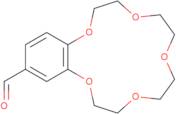4'-Formylbenzo-15-crown 5-Ether
CAS: 60835-73-6
Ref. 3D-FF62086
| 25mg | Discontinued | ||
| 50mg | Discontinued | ||
| 100mg | Discontinued | ||
| 250mg | Discontinued | ||
| 500mg | Discontinued |
Product Information
- 2,3-(4-Formylbenzo)-1,4,7,10,13-pentaoxacyclopentadec-2-ene
- 1,4,7,10,13-Benzopentaoxacyclopentadecin-15-carboxaldehyde, 2,3,5,6,8,9,11,12-octahydro-
- 15-Formyl-2,3,5,6,8,9,11,12-octahydro-1,4,7,10,13-benzopentaoxacyclopentadecine
- 15-Formylbenzo[15-crown-5]
- 2,3,5,6,8,9,11,12-Octahydro-1,4,7,10,13-Benzopentaoxacyclopentadecine-15-Carbaldehyde
- 2,3,5,6,8,9,11,12-Octahydro-1,4,7,10,13-benzopentaoxacyclopentadecin-15-carboxaldehyde
- 4-Formylbenzo-15-crown 5-ether
- NSC 288923
- 4-Formylbenzo-15-crown-5
- 4′-Formylbenzo-15-crown-5
- See more synonyms
4'-Formylbenzo-15-crown 5-ether is a ligand with a macrocyclic structure. It is not soluble in many solvents, so it is usually used as an introducing agent for lanthanide complexes. Its fluorescence can be observed when the compound is exposed to UV light and its protonation state can be determined by the intensity of the fluorescence. The compound also has a high proton affinity, which causes it to evaporate easily. When the compound is heated, it forms the more stable 4'-formylbenzo-15-crown 5-ether tetraethyleneglycol. This technique has been used to study the formation constants of various lanthanide complexes.





